Greenville
Houses within 10km of this house
Displaying 37 houses.
Houses within 10km of Greenville
Displaying 37 houses.
| House name | Description | |
|---|---|---|
| Kilcondy | Kilcondy was occupied by William Davies, medical doctor, in 1837 and by John F. Beale at the time of Griffith's Valuation. Beale held the property from Richard Rye and the buildings were valued at £18+. The Crooke sale rental of 1860 records the leasing of 97 acres of Kilcondy including the dwelling house to Richard Browne Crooke by Richard Tonson Rye in 1840 for 3 lives. John Fleming Beale is given as the tenant. Earlier, in 1786, Wilson refers to Kilcondie as the seat of Mr. Crooke. It is now a ruin. | |
| Carrigboy | E. Barrett resided at Carriguoy, parish of Kilmichael, in 1837. At the time of Griffith's Valuation John E. Barrett occupied this house valued at £15.10 shillings and held by him in fee. A lithograph of the house, with the hunt assembled outside the hall door, is included in the rental. | |
| Raleigh | In 1837 Raleagh was the residence of W. Minhear. James Minhear was occupying this house in the mid 19th century. He held it from the representatives of - Carleton and it was valued at £20.10 shillings. | |
| Ashgrove | A home of the Ashe family from at least the 1770s this house was held by Richard Ashe from the Court of Chancery at the time of Griffith's Valuation and was valued at £13.10 shillings. He is also recorded as resident in 1814 and 1837. The sale rental of 1850 records that the house had lately been in the possession of Jeremiah Twomey. This house was owned by Captain Thomas Leader in the 1870s. In 1872 Robert Warren, a younger brother of Sir Augustus Warren, married Blanche Louise, daughter of Captain Leader. Robert Warren, with an address at Ashgrove, Macroom, is also recorded as a county Cork landowner in the 1870s. It is no longer extant though a small number of ruins remain. | |
| Codrum | In 1837 Edward Ashe was occuping a house in the townland of Condrum and this house remained the residence of Edward Ashe until at least the 1870s. In the early 1850s it was valued at £18.15 shillings. It is labelled Codrum West on the 1st edition Ordnance Survey map and as Codrum on the later 25-inch edition of the 1890s. It is still extant. |
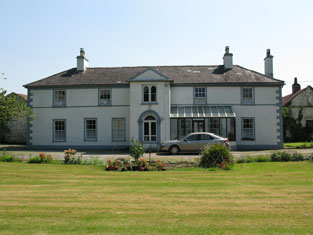
|
| Kilbarry House | The Barrys were resident at Kilbarry from at least the latter part of the 18th century. J. Barry was occupying the house in 1837 and Nicholas Barry in the early 1850s when it was valued at £11. Nicholas Barry held the property from Henry Hatchell and Thomas Leader. A house is still extant at the site. | |
| Dromcarra House | In 1837 Lewis records J. Barter as resident at a house called Lee Mount in the parish of Inchigeelagh. The name Joseph M. Barter of Dromcarra House appears in the list of subscribers to Lewis. Thomas Barter held a house valued at £11.5 shillings in fee in Dromcarra North at the time of Griffith's Valuation. John Barter was resident at Droumcarra in the 1870s and John William Barter in 1906. A house still exists at the site. | |
| Cooldaniel | This house was the home of Barter esq in the 1770s and 1780s, of Thomas Barter in 1814, of J. Barter in 1837 and of Michael Buckley at the time of Griffith's Valuation who held it from William Gallagy. It was valued at £10. In the 1940s the Irish Tourist Association Survey noted that it had been converted to farm buildings.. | |
| Boyle Grove | Boyle Grove was the residence of William Boyle in 1814 and of J. Boyle in 1837. The 1821 Census for Dromcarra records William Boyle, a gentleman farmer aged 65 and his wife Sophia, their two sons, William and James, and their daughters, see http://myhome.ispdr.net.au/~mgrogan/cork/inch_1821_cen.htm#Dromcarra By the time of Griffith's Valuation the house was occupied by Devonshire Hawkes who held it from the Court of Chancery. It was valued at £12.15 shillings. In March 1852 Boylesgrove, the estate of William Boyle, was advertised for sale. The rental records that the house was let to Devonsher P. Hawkes for 7 years in 1849 by the Court of Chancery. A house still exists at the site. | |
| Ballytrasna | Located on the Earl of Bandon's estate, occupied by the Reverend B. Gash in 1837 and by Thomas Neville in the early 1850s when the house was valued at £10. The location of this house now appears to be under water. | |
| Curraclogh House | Mary Gibson occupied this house at the time of Griffith's Valuation. It was held from Sir Augustus Warren and was valued at £12.10 shillings. This house is no longer extant. | |
| Codrum House | In the 1770s and 1780s Codrum was occupied by Hutchinson esq. It was the residence of John Warren in 1814. There were two houses in this townland at the time of Griffith's Valuation, one occupied by Richard Ashe and the other by Massy H. Warren. The Warren house was known as Codrum House. It was valued at £19. Frederick H. Warren was resident in the 1870s. In 1944 the Irish Tourist Association Survey referred to Codrum as the home of Mrs.S.W. Baldwin and also to the murder of Colonel Hutchinson there. The original house at this site is now a ruin. | |
| Elmglyn | Elmglyn was the residence of T. Gollock in 1837 and of Patrick Daly at the time of Griffith's Valuation. He held the property from the representatives of Thomas Gollock and the buildings were valued at £11. The original house is not extant. | |
| Mount Massy | This house was the residence of Hutchinson esq in the 1770s. Occupied by Hubert [Herbert?] Baldwin in 1814 and by M.H. Massey in 1837. Mount Massy appears to be in use as an auxiliary workhouse at the time of Griffith's Valuation, when the buildings were valued at £50. At the time of the sale in 1861 Mount Massy was in the owner's possession and was held under a fee farm grant from the Earl of Bandon, dated 2 Feb 1859. It was burnt in December 1920 during the War of Independence and is now a ruin. | |
| Lissardagh | The residence of William Baldwin at the time of Griffith's Valuation, held by him in fee and valued at £20. There is still a house extant at this location. |
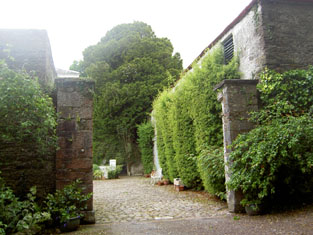
|
| Firville | Leet lists a Robert McCarthy residing at a house called Fir-ville, Macroom in 1814. Lewis refers to Firville, the newly erected mansion of Philip Harding. Henry Harding was the occupier in the early 1850s holding the property from N.D. Murphy. It was valued at £19.10 shillings. The representatives of Henry Harding still owned Firville in the 1870s. Firville passed to the Barry family through the marriage of Ellen Harding, daughter of Henry Harding, and Thomas Barry, son of Michael Barry of Elm Park, Farran, county Cork, land agent to Sir Riggs Falkiner. In 1944 the Irish Tourist Association Survey noted that Firville was then the residence of F. St.Aubyn Horgan, who had connections with the Channel Islands. Firville is still extant and occupied. | |
| Coolcour/Coolcower | Home of the Browne family in the 18th and 19th centuries, occupied by John Browne in 1814, by W.G. Browne in 1837 and still his residence in the 1870s. In the early 1850s the house was valued at £46 and was held in fee. St George G. Browne was resident in 1906. Coolcour was burnt in July 1921, just before the end of the War of Independence, when it was the residence of Richard C. Williams, a hotel owner in Macroom. It was rebuilt and now functions as a guest house, see http://www.coolcowerhouse.ie/ |
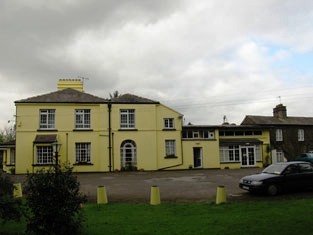
|
| Coolyhane | Lewis refers to Coolehane as recently erected, Richard Ashe was proprietor. Richard Ashe was still the occupier in the early 1850s and held the property from Elizabeth Foote when it was valued at £15.15 shillings. In 1944 the Irish Tourist Association Survey noted that it had formerly belonged to the Ashe family but was then the home of Mr. Purcell, solicitor. It is still extant. | |
| Gurteenroe Cottage | A house valued at £10.15 shillings was occupied by James Welpy on the Hedges estates at Gurteenroe in the early 1850s. In the 1870s and 1880s the home of Charles Raycroft. It is still extant and well-maintained. |

|
| Mount Hedges | Mount Hedges, formerly a family residence, had by the time of Griffith's Valuation become the steward's house, valued at £15. In 1786 Wilson had referred to it as "the beautiful seat of Captain Robert Hedges". There are some ruins remaining at the site. | |
| Macroom Castle | In 1750 Charles Smith recorded Macroom Castle as the residence of Richard Hedges Eyre. Lewis wrote in 1837 that Macroom was "till very lately..the joint property of the Earl of Bandon and Robert Hedges Eyre" but was then the sole property of the latter, who had converted the ancient castle into an elegant modern mansion. Held by the Honourable William Henry White Hedges in fee at the time of Griffith's Valuation, when the buildings were valued at £80. Slater records it as being a seat of Lord Ardilaun in 1894. Macroom Castle was burnt in 1922. In 1944 the Irish Tourist Association Survey gathered a detailed history of the building, noting that "it was burnt in all about five times" in its long history. The impressive gateway is all that remains. |

|
| Rockborough | Rockborough was the home of T. Mitchel Browne in 1837. Situated on the Hedges estate it was occupied by John G. Browne in the early 1850s, when it was valued at £25. In 1944 the Irish Tourist Association Survey noted that it had formerly belonged to the Brownes but was then the home of the Twomey family. This property is still extant. | |
| Sandy Hill | Home of the Reverend John Orpin in 1814, by 1837 this house was the residence of Thomas S. Coppinger and remained a Coppinger home for the rest of the 19th century. Located on the Hedges White estate it was valued at £9 in the 1850s. In 1944 the Irish Tourist Association Survey reported that it was the residence of Timothy Lucey, solicitor. There is still an extant house at the site. | |
| Shandangan House | Smith records Christopher Earbury as resident at Shandangan in 1750. Devonsher Esq was the proprietor of Shandangan in the 1770s and 1780s. A Mr Timothy Mahony was living at Shandangan, Macroom in 1814. Lewis records S. Penrose as the proprietor of Shandangan (parish of Kilmurry) in 1837 and Samuel Penrose was still occupying the house at the time of Griffith's Valuation. He held it in fee and it was valued at £13.10 shillings. | |
| Old Fort | A house occupied by Henry Good at the time of Griffith's Valuation, held from Samuel Penrose and valued at £18.10 shillings. | |
| Killinardrish House | Lewis describes this house as a "elegant Italian lodge lately built by R. J. O’Donoghue". It was valued at £38 and held from Sir Augustus Warren. In 1944 the Irish Tourist Association Survey noted that it was the residence of Mr. O'Donovan, manager of the creamery at Lissarda. Killinadrish is still extant. There was also a steward's house in this townland occupied by members of the Crooke family. |
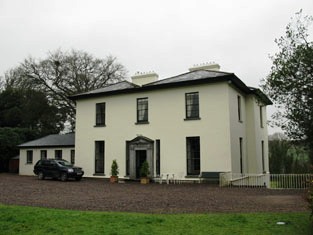
|
| Warren's Court | Kilbarry was bought by the Warrens in the late 17th century. The house Warren's Court was built in the 18th century and was the main seat of this family in the 18th and 19th centuries. In 1750 Smith refers to Kilbarry the "handsome house" of Robert Warren. Wilson notes it as "the fine seat of Thomas Warren" in 1786. In 1894 Slater refers to it as the seat of Sir A. Warren. In 1906 it was valued at £66 and occupied by Sir Augustus Riversdale Warren.. It was burnt in June 1921 during the War of Independence when it was the residence of Sir Augustus D. Warren. The original house is no longer extant. In the 1940s the Irish Tourist Association Survey reported that a modern two-storey house had been constructed nearby. | |
| Crookstown | Smith records Mr Crook of Crookstown in 1751. The mother of Robert Warren, 1st Baronet, was Anne Crooke and this house may have got its name from her. It was the home of a branch of the Warren family from the late 18th century, occupied by the Reverend E. W. Warren in 1814, by the Reverend R. Warren in 1837 and in the early 1850s. The Reverend Robert Warren held the property in fee and the buildings were valued at £48. It was burnt in June 1921 during the War of Independence when it was the residence of Robert Warren. It is still extant and occupied. |
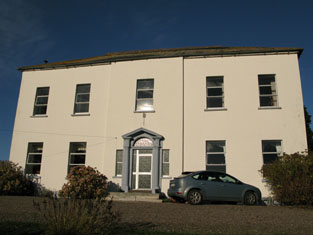
|
| Warrensgrove | This house was the home of John Borlase Warren who succeeded his brother Sir Augustus Warren as 4th Baronet. He is recorded as being resident in 1837 and at the time of Griffith's Valuation when he held the property from Sir A. Warren. The buildings were valued at £48. In the 1940s the Irish Tourist Association Survey noted that Warrensgrove had been burnt in 1921. The original house is now a ruin but buildings adjacent have been redeveloped as a country house. In 2014, the property, including the ruin, was offered for sale. |

|
| Bellmount | Bellmount, Innishannon was the residence of the Reverend James Crowley in 1814. T. Herrick was the proprietor of Bellmount in 1837 along with a large flour mill. The mill and house were in the possession of Patrick Howard at the time of Griffith's Valuation and held from John E. Herrick. The house was valued at £18 and the mill at £65. The mill building, though now disused, is still extant. |
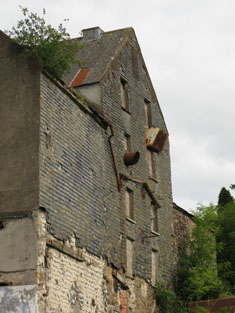
|
| Shandangan East | A house occupied by Patrick Hassett at the time of Griffith's Valuation held from Samuel Penrose and valued at £18.10 shillings. This property is labeled Larch Hill House on the 25-inch Ordnance Survey Map of the 1890s. It is still extant and occupied. |
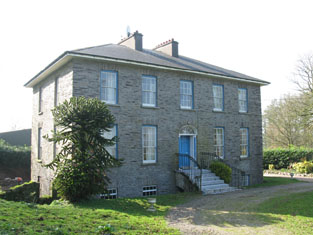
|
| Raheen House (Kinalmeaky) | Held by Augustus Warren but unoccupied at the time of Griffith's Valuation,when it was valued at £9. Noted by Leet as the property of William Warren in 1814. The original house is no longer extant. | |
| Killaneer House | Occupied by Francis Beamish in perpetuity at the time of Griffith's Valuation, when it was valued at £22. Leet refers to it as the seat of Thomas Gash in 1814. Buildings are still extant at the site. | |
| Mossgrove | Held in fee by Samuel Baldwin in 1851 when it had a valuation of £20. Also noted as his residence by Lewis in 1837. Mossgrove seems to have pre-dated Mount Pleasant as the Baldwin residence in this area. There is still an extant house at this site. | |
| Mossgrove Lower | Mossgrove Lower appears on the 1st edition Ordnance Survey map close to the site of a fortified house dating from the early modern period which is recorded as "in ruins" by the 1830s. In 1851 Henry Baldwin was leasing the property here to Thomas Barter when it was valued at £9. Leet notes a property at Mossgrove as the residence of Robert Popham in 1814. It was no longer extant by the publication of the 25-inch map of the 1890s, | |
| Capeen | Richard Hungerford was leasing this property to Henry Hungerford in 1851 when it was valued at almost £10. Labelled Cappeen on the 1st edition Ordnance Survey Map. An enlarged building is named Cappeen House on the 25-inch map of the 1890s. A house still exists at the site. | |
| Castle View | A house located just east of the present day reservoir south of Macroom. Lewis records P. Ronayne as resident at Castleview in 1837. Patrick Ronane was the occupier of a house valued at £11 in this townland in the mid 19th century. The sale rental of April 1861 describes the house as "commodious" with a walled in garden. It was held on a lease from Michael Cox to John Ronayne as trustee for Thomas Browne dated 1800. Buildings are still located at this site. |

